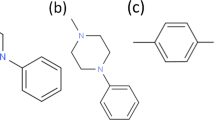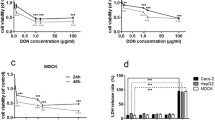Abstract
Cadmium (Cd) is a toxic metal with an extremely long half-life in humans. The intestinal absorption of Cd has been extensively studied but the role the intestinal epithelium may play in metal excretion has never been considered. The basolateral (BL)-to-apical (AP) transepithelial transport of Cd was characterized in TC7 human intestinal cells. Both AP and BL uptakes varied with days in culture, and BL uptake was twofold higher compared to AP in differentiated cultures. A 50% increase in the BL uptake of 0.5 μM 109Cd was observed at pH 8.5 in a chloride but not nitrate medium, suggesting the involvement of a pH-sensitive mechanism of transport for chloro-complexes. Fe and Zn inhibited the BL uptake of Cd whereas complexation by albumin had no effect, but the stimulatory effect of pH 8.5 was lost in the presence of albumin. The BL uptake of [3H]-MPP+ and 109Cd were both inhibited by decynium22 without reciprocal inhibition. MRP2 and MDR1 mRNA levels increased as a function of days in culture. A 25 and 20% decrease in the cellular AP efflux of Cd was observed in the presence of verapamil and probenecid, respectively. In cells treated with BSO, which lowered by 26% the total cellular thiol content, the inhibitory effect of verapamil increased, whereas that of probenecid decreased. These results reveal the existence of a decynium22-sensitive mechanism of transport for Cd at the BL membrane, and suggest the involvement of MDR1 and MRP2 in cellular Cd efflux at the AP membrane. It is conceivable that the intestinal epithelium may contribute to Cd blood excretion.







Similar content being viewed by others
Abbreviations
- DMEM:
-
Dulbecco’s modified eagle essential minimum medium
- FBS:
-
Fetal bovine serum
- MDR1:
-
Multidrug resistance
- MPP+ :
-
1-Methyl-4-phenylpyridinium iodide
- MRP:
-
Multidrug resistance-associated protein
- MTT:
-
3-[4,5-Dimethyl-2-thiazol-2-yl]-2,5-diphenyltetrazolium bromide
- OCT:
-
Organic cation transporter
- TEER:
-
Transepithelial electrical resistance
References
Adamsson E, Piscator M, Nogawa K (1979) Pulmonary and gastrointestinal exposure to cadmium oxide dust in a battery factory. Environ Health Perspect 28:219–222
Andersen O, Nielsen JB, Svendsen P (1988) Oral cadmium chloride intoxication in mice: effects of dose on tissues damage, intestinal absorption and relative organ distribution. Toxicology 48:225–236
Berggren S, Gall C, Wollnitz N, Ekelund M, Karlbom U, Hoogstraate J, Schrenk D, Lennernäs H (2007) Gene and protein expression of P-glycoprotein, MRP1, MRP2, and CYP3A4 in the small and large human intestine. Mol Pharm 4:252–257
Bissonnette P, Gagné H, Coady MJ, Benabdallah K, Lapointe JY, Bertheloot A (1996) Kinetic separation and characterization of three sugar transport modes in Caco-2 cells. Am J Physiol 270:G833–G843
Bradford MM (1976) A rapid and sensitive method for the quantitation of microgram quantities of protein utilizing the principle of protein–dye binding. Anal Biochem 72:248–254
Broeks A, Janssen HW, Calafat J, Plasterk JH (1996) A P-glycoprotein protects Caenorhabditis elegans against natural toxins. EMBO J 14:1858–1866
Cardin GB, Mantha M, Jumarie C (2009) Resistance to cadmium as a function of Caco-2 cell differentiation: role of reactive oxygen species in cadmium- but not zinc-induced adaptation mechanisms. Biometals 22:752–769
Chantret I, Rodolosse A, Barbat A, Dussaulx E, Brot-Laroche E, Zweibaum A, Rousset M (1994) Differencial expression of sucrase-isomaltase in clones isolated from early and late passages of the cell line Caco-2: evidence for glucose-dependent negative regulation. J Cell Sci 107:213–225
Dijkstra M, Havinga R, Vonk RJ, Kuipers F (1996) Bile secretion of cadmium, silver, zinc and copper in the rat. Involvement of various transport systems. Life Sci 59:1237–1246
Drab M, Verkada P, Elger M, Kasper M, Lohn M, Lauterbach B, Menne J, Lindschau C, Mende F, Luft FC, Schedi A, Haller H, Kurzchalia TV (2001) Loss of caveolae, vascular dysfunction, and pulmonary defects in caveolin-1 gene-disrupted mice. Science 293:2449–2452
Duizer E, Gilde AJ, Versantvoort CHM, Groten JP (1999) Effects of cadmium chloride on the paracellular barrier function of intestinal epithelial cell lines. Toxicol Appl Pharmacol 155:117–126
Duràn JM, Peral MJ, Calonge ML, Llundàin AA (2005) OCTN3: A Na+-independent l-carnithine transporter in entercoytes basolateral membrane. J Cell Physiol 202:929–935
Elisma F, Jumarie C (2001) Evidence for cadmium uptake through Nramp2: metal speciation studies with Caco-2 cells. Biochem Biophy Res Commun 285:662–668
Englund G, Rorsman F, Rönnblom A, Karlbom U, Lazorova L, Grasjö J, Kindmark A, Artusson (2006) Regional levels of drug transporters along the human intestinal tract: co-expression of ABC and SLC transporters and comparison with Caco-2 cells. Eur J Pharma Sci 29:269–277
Engman HA, Lennernäs H, Taipalensuu J, Otter C, Leidvik B, Artusson P (2001) CYP3A4, CYP3A5, and MDR1 in human small and large intestinal cell lines suitable for drug transport studies. J Pharma Sci 90:1736–1751
Friberg L, Elinder CG, Kjellstrom T, Nordberg GF (1985) Cadmium and health. A toxicological and epidemiological appraisal, vol 1. CRC Press, Boca Raton
Gorboulev V, Ulzheimer JC, Akhoundova A, Ulzheimer-Teuber I, Karbach U, Quester S, Baumann C, Lang F, Busch AE, Koepsell H (1997) Cloning and characterization of two human polyspecific organic cation transporters. DNA Cell Biol 16:871–881
Gründemann D, Gorboulev V, Gambaryan S, Veyhl M, Koepsell H (1994) Drug excretion mediated by a new prototype of polyspecific transporter. Nature 372:549–552
Hansen GH, Niels-Christiansen LL, Thorsen E, Immerdal L, Danielsen EM (2000) Chelesterol depletion of enterocytes. Effect on the golgi complex and apical membrane trafficking. J Biol Chem 275:5136–5142
Harrap KR (1967) The application of 5,5′-dithiobis-2-nitrobenzoic acid to the determination of the acid-soluble disulphide content of blood. Biochem Pharmacol 16:725–731
Hayer-Zillgen M, Brüss M, Bönisch H (2002) Expression and pharmacological profile of the human organic cation transporters hOCT1, hOCT2 and hOCT3. Br J Pharmacol 136:829–836
Hoffmann U, Kroemer HK (2004) The ABC Transporters MDR1 and MRP2: multiple functions in disposition of xenobiotics and drug resistance. Drug Metab Rev 36:669–701
Jarup L, Berglund M, Elinder CG, Nordberg G, Vahter M (1998) Health effects of cadmium-exposure. A review of the literature and risk estimate. Scand J Work Environ Health 24:1–51
Jumarie C, Malo C (1994) Alkaline phosphatase and peptidase activities in Caco-2 cells: differential response to triiodothyronine. In Vitro Cell Dev Biol Anim 30A:753–760
Jumarie C, Campbell PGC, Berteloot A, Houde M, Denizeau F (1997) Caco-2 cell line used as an in vitro model to study cadmium accumulation in intestinal epithelial cells. J Membr Biol 158:31–48
Jumarie C, Campbell PGC, Houde M, Denizeau F (1999) Evidence for an intracellular barrier to cadmium transport through Caco-2 cell monolayers. J Cell Physiol 180:285–297
Jumarie C, Fortin C, Houde M, Campbell PGC, Denizeau F (2001) Cadmium uptake by Caco-2 cells: effects of Cd complexation by chloride, glutathione, and phytochelatins. Toxicol Appl Pharmacol 107:29–38
Kerper LE, Ballatori N, Clarkson TW (1992) Methylmercury transport across the blood–brain barrier by amino acid carrier. Am J Physiol 262:R761–R765
Koepsell H, Endou H (2004) The SLC22 drug transporter family. Eur J Physiol 447:666–676
Kouji H, Inazu M, Yamada T, Tajima H, Aoki T, Matsumiya T (2009) Molecular and functional characterization of choline transporter in human colon carcinoma HT-29 cells. Arch Biochem Biophys 483:90–98
Leblondel G, Allain P (1999) Manganese transport by Caco-2 cells. Biol Trace Elem Res 67:13–28
Mahraoui L, Rodolosse A, Barbat A, Dussaulx E, Zweibaum A, Rousset M, Brot-Laroche E (1994) Presence and differential expression of SGLT1, GLUT1, GLUT2, GLUT3 and GLUT5 hexose-transporters mRNAs in Caco-2 cell clones in relation to cell growth and glucose consumption. Biochem J 15:629–633
McMahon RJ, Cousins RJ (1998) Regulation of the zinc transporter ZnT-1 by dietary zinc. Proc Natl Acad Sci USA 95:4841–4846
Mossmann T (1983) Rapid colorimetric assay for cellular growth and survival: application to proliferation and cytotoxicity assays. J Immunol Methods 65:55–63
Nakayama A, Saitoh H, Oda M, Takada M, Aungst BJ (2000) Region-dependent disappearance of vinblastine in rat small intestine and characterization of its P-glycoprotein-mediated efflux system. Eu J Pharm Sci 11:317–324
Nordberg GF, Kjellstrom T (1979) Metabolic model for cadmium in man. Environ Health Perspect 28:211–217
Pham TN, Segui JA, Fortin C, Campbell PGC, Denizeau F, Jumarie C (2004) Cadmium uptake in rat hepatocytes in relation to speciation and to complexation with metallothionein and albumin. J Cell Physiol 201:320–330
Pinot F, Freps SE, Bachelet M, Hainaut P, Bakonyi M, Polla BS (2000) Cadmium in the environment: sources mechanisms of biotoxicity and biomarkers. Rev Environ Health 15:299–323
Pinto M, Robine-Leon S, Appay MD (1983) Enterocyte-like differentiation and polarization of the human colon carcinoma cell line Caco-2 in culture. Biol Cell 47:323–330
Prozialeck WC, Lamar PC (1993) Surface binding and uptake of cadmium (Cd2+) by LLC-PK1 cells on permeable membrane supports. Arch Toxicol 67:113–119
Raffaniello RD, Lee SY, Teichberg S, Wapnir RA (1992) Distinct mechanisms of zinc uptake at the apical and basolateral membranes of Caco-2 cells. J Cell Physiol 152:356–361
Roberts CA, Clark JM (1988) In vivo depression of reserve albumin binding capacity by cadmium: a preliminary evaluation. Life Sci 42:1369–1374
Rodal SK, Skretting G, Garred O, Vilhardt F, van Deurs B, Sandvig K (1999) Extraction of cholesterol with methyl-beta-cyclodextrin perturbs formation of clathrin-coated endocytic vesicles. Mol Biol Cell 10:961–974
Rousset M, Chantret I, Darmoul D (1989) Reversible forskolin induced impairment of sucrase-isomaltase mRNA levels, biosynthesis and transport to the brush border membrane in Caco-2 cells. J Cell Physiol 141:627–635
Rusch GM, O’Grodnick JS, Rinehart WE (1986) Acute inhalation study in rat of comparative uptake, distribution and excretion of different cadmium containing materials. Am Ind Hyg Assoc 47:754–763
Seithel A, Karlsson J, Hilgendorf C, Björquist A, Ungell AL (2006) Variability in mRNA expression of ABC- and SLC-transporters in human intestinal cells: comparison between human segments and Caco-2 cells. Eur J Pharm Sci 28:291–299
Shaikh ZA, Blazka ME, Endo T (1995) Metal transport in cells: cadmium uptake by rat hepatocytes and renal cortical epithelial cells. Environ Health Perspect 103:73–75
Shen H, Qin H, Guo J (2008) Cooperation of metallothionein and zinc transporters for regulating zinc homeostasis in human intestinal Caco-2 cells. Nutr Res 28:406–413
Sugawara N, Lai YR, Sugaware C, Arizono K (1998) Decreased hepatobiliary secretion of inorganic mercury, its deposition and toxicity in the Eisai hyperbilirubinemic rat with no hepatic canalicular organic anion transporter. Toxicology 126:23–31
Szczypka MS, Wemmie JA, Moye-Rowley WS, Thiele DJ (1994) A yeast metal resistance protein similar to human cystic fibrosis transmembrane conductance regulator (CFTR) and multidrug resistance-associated protein. J Biol Chem 269:22853–22857
Traber PG (1994) Differentiation of intestinal epithelial cells: lessons from the study of intestine-specific gene expression. J Lab Clin Med 128:467–477
Urakami Y, Okuda M, Masuda S, Saito H, Inui KI (1998) Functional characteristics and membrane localization of rat multispecific organic cation transporters, OCT1 and OCT2, mediating tubular secretion of cationic drugs. J Pharmacol Exp Ther 287:800–805
Vachon PH, Beaulieu JF (1992) Transient mosaic patterns of morphological and functional differentiation in the Caco-2 cells. Gastroenterology 103:414–423
Wang LH, Rothberg KG, Anderson RG (1993) Mis-assembly of clathrin lattices on endosomes reveals a regulatory switch for coated pit formation. J Cell Biol 123:1107–1117
Zhang L, Gorset W, Dresser MJ, Giacomini KM (1999) The interaction of n-tetraalkylammonium compounds with a human organic cation transporter, hOCT1. J Pharmacol Exp Ther 288:1192–1198
Acknowledgments
This research was supported by NSERC (Discovery grant CJ), the Natural Sciences and Engineering Research Council of Canada.
Author information
Authors and Affiliations
Corresponding author
Rights and permissions
About this article
Cite this article
Carrière, P., Mantha, M., Champagne-Paradis, S. et al. Characterization of basolateral-to-apical transepithelial transport of cadmium in intestinal TC7 cell monolayers. Biometals 24, 857–874 (2011). https://doi.org/10.1007/s10534-011-9440-7
Received:
Accepted:
Published:
Issue Date:
DOI: https://doi.org/10.1007/s10534-011-9440-7




